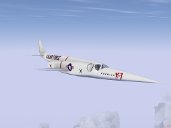Douglas X-3
Jump to navigation
Jump to search
| This article is a stub. You can help the wiki by expanding it. |
 | |
|---|---|
 | |
 | |
| Type | Experimental aircraft |
| Configuration | Delta-wing aircraft |
| Propulsion | Twinjet (Jet aircraft, Twin-engine aircraft) |
| Manufacturer | Douglas |
| Author(s) |
|
| FDM | YASim |
| --aircraft= | stiletto |
| Status | Beta |
| FDM |
|
| Systems |
|
| Cockpit |
|
| Model |
|
| Development | |
| Hangar |
|
| Website |
|
| Repository |
|
| Download |
|
| License | GPLv2+ |
|
| |
The Douglas X-3 Stiletto was a 1950s United States experimental jet aircraft with a slender fuselage and a long tapered nose, manufactured by the Douglas Aircraft Company. It was designed to investigate supersonic flight. The aircraft was built of titanium, but was underpowered, and was unable to exceed Mach 1 in level flight. Data recorded by the testing of this plane assisted Lockheed Engineers in building the Lockheed F-104 Starfighter which used a similar wing to achieve Mach 2. The highest it could achieve was Mach 1.208 in a 30° dive.
Specs
General characteristics
- Crew: one
- Length: 66 ft 9 in (20.3 m)
- Wingspan: 22 ft 8 in (6.9 m)
- Height: 12 ft 6 in (3.8 m)
- Wing area: 166.5 ft² (15.47 m²)
- Empty weight: 16,120 lb (7,310 kg)
- Max. takeoff weight: 23,840 lb (10,810 kg)
- Powerplant: 2 × Westinghouse J34 afterburning turbojet, 3,370 lbf, 4,850 lbf with afterburning (15.0 kN, 21.6 kN with afterburning) each
Performance
- Maximum speed: 700 mph (1,125 km/h)
- Range: 497 mi (800 km)
- Service ceiling: 38,000 ft (11,600 m)
- Thrust/weight: 0.40
External Links
| ||||||||